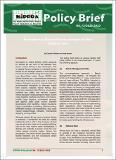| dc.description.abstract | Compared to inland fishing, which accounts
for almost 80 per cent of the fisheries subsector,
marine fishing is less developed. This
is despite Kenya’s potential in industrial fishing
based on her strategic location in the Exclusive
Economic Zone (EEZ) along the most endowed
tuna South-West Indian Ocean (SWIO) belt.
Marine fisheries are a conventional component
of the Blue Economy whose goal is to strike a
balance between economic opportunities and
environmental limitations to generate wealth
from oceans. Besides marine fishing, Blue
Economy comprises inland fishing, aquaculture,
maritime law, safety and security, tourism,
marine transport, shipbuilding and repair, marine
cargo logistics maritime education and training,
marine cargo logistics, port-related services,
port agency, water sport, marine, maritime
governance, ship handling, marine insurance,
cargo consolidation, bunkering, offshore mining,
renewable energy, bio-prospecting, blue data,
marine biotechnology, transport, international
shipping, among others. | en |

